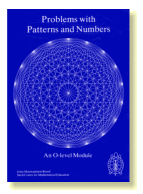Problems with Patterns and Numbers (1984)
 Problems with Patterns
and Numbers has become an influential book on the teaching of problem
solving. It focuses on non-routine problem solving in mathematics, and the
teaching strategies needed to handle it in the classroom. It is aimed at the
upper half of the ability range and ages 13-16, but is more widely applicable
with some adaptation. The classroom materials, covering three to six weeks
work, provide close detailed support for the pupils (and the teacher) in the
initial stages: this is gradually reduced as they become more experienced
until they are in a position to tackle a wide range of unfamiliar problems
and assessment tasks on their own. Most of the problems have both spatial
and numerical aspects. There are five short chapters on aspects of tackling
problem solving in the classroom, including a question marking exercise.
Problems with Patterns
and Numbers has become an influential book on the teaching of problem
solving. It focuses on non-routine problem solving in mathematics, and the
teaching strategies needed to handle it in the classroom. It is aimed at the
upper half of the ability range and ages 13-16, but is more widely applicable
with some adaptation. The classroom materials, covering three to six weeks
work, provide close detailed support for the pupils (and the teacher) in the
initial stages: this is gradually reduced as they become more experienced
until they are in a position to tackle a wide range of unfamiliar problems
and assessment tasks on their own. Most of the problems have both spatial
and numerical aspects. There are five short chapters on aspects of tackling
problem solving in the classroom, including a question marking exercise.
"By addressing the query of 'how do you assess open ended problem solving', the Shell team generated a classic resource, from which has grown the substantial literature of alternative assessment of today." - AAMT
"The materials are very well produced with attractive worksheets and an abundance of materials from which to select." - Mathematical Gazette
Problemas con pautas y números, the Spanish language edition of Problems with Patterns and Numbers is available from Servicio Editorial, Universidad del País Vasco, Apdo. postal 1.397, E-48080 Bilbao, Spain (and not from the Shell Centre).
The materials comprise a teacher's guide and a set of worksheet masters for photocopying.
Unless stated otherwise, these materials are Copyright © Shell Centre for Mathematical Education (see the materials for full details). You may download these materials for personal use and freely repoduce them for non-commercial purposes including teaching, research and staff development within your institution. For other uses, please contact the Bell Burkhardt Daro Shell Centre Trust at publications@mathshell.com for information.
Teaching Strategic Skills series
These materials were originally developed with the Joint Matriculation Board as modules for an O-Level/GCSE mathematics examination. This was initially successful, but the program had to be dropped as a result of changes to the examination system. However, the two books that were produced recieved widespread acclaim and have influenced mathematics teaching around the world, with The Language of Functions and Graphs winning the 2008 ISDDE Prize for Excellence in Educational Design.
The aim of this series of Modules was gradually to introduce into the examination questions that would encourage a balanced range of classroom activities. It was particularly concerned with those activities highlighted by the Cockcroft Report: problem solving, practical mathematics, discussion and open investigation.
Although the specific references to O-Level examinations are clearly outdated, these are rare. The teaching approaches and activities described remain valid and applicable to any Mathematics curriculum.
